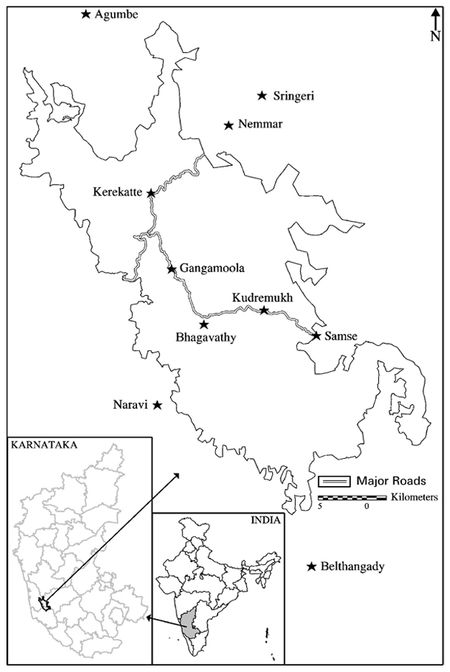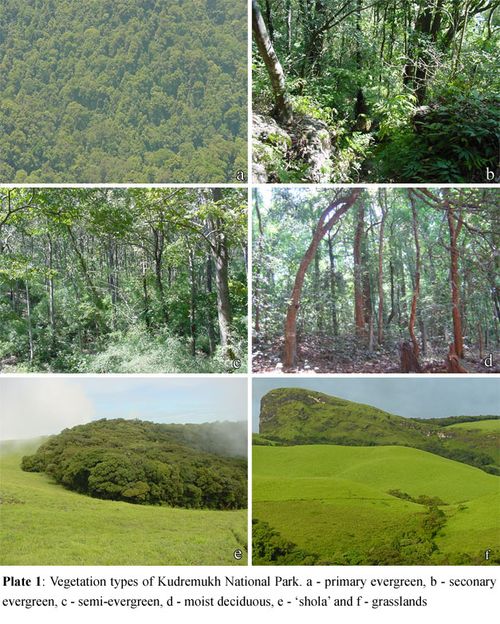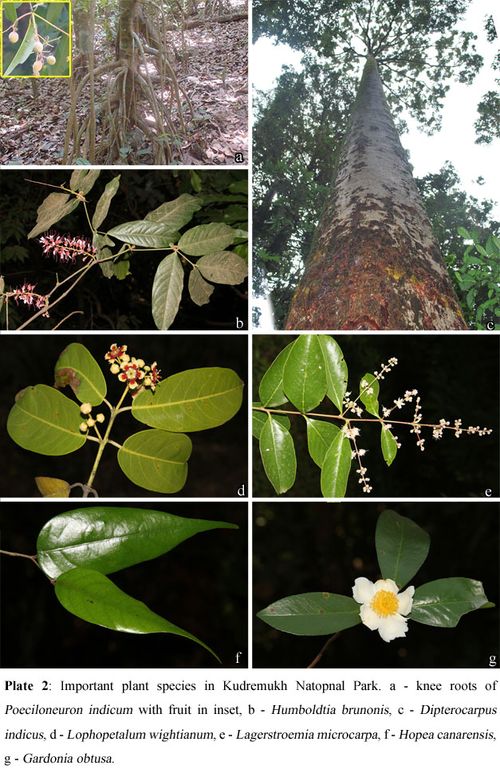A. N. Sringeswara1,2, M. B. Shivanna1 and Balakrishna Gowda2 |
   |
| l |
Abstract
Floristic diversity in the Kudremukh National Park has been compiled based on the vegetation survey and with consultation of literature and herbarium collections during the year 2003-2005. A total of 897 species including 12 sub species and 34 varieties belonging to 125 families and 43.14% of the taxa falling in the ten dominant families. Fabaceae is the dominant family with 38 genera and 75 species and it accounts for 8.36% of the total taxa recorded followed by Orchidaceae (38 genera; 68 species; 7.58%) and Rubiaceae (30 genera; 49 species; 5.46%). Herbs are the dominant growth forms with 316 species (35.23%) followed by trees (277 species; 30.88%) and climbers and creepers (127 species; 14.16%). There are 584 Phanerophytes (65.11%), 160 therophytes (17.84%), 68 cryptophytes (7.58%), 53 hemicryptophytes (5.91%) and 32 chameophytes (3.57%). Based on the physiognomic study the climate of the national park is classified as phanero-therophytic.
Keywords: Kudremukh National Park, Floristic diversity, Western Ghats
Introduction
Floristic diversity refers to the variety of plants and their variation. It is a well-organized complex association having a typical composition (floristic aspect) and structure (morphological aspect), which results from the interaction through time. It can be measured in different levels with just a number of species in a given area to a complex association with prevailing ecosystem. The Western Ghats with a chain of mountains running parallel to the west coast covering 5% of the India’s total geographical area with humid tropical forest and high diversity contains more than 27% of the country’s total plant species and constitutes regions of high endemism in India (Rodgers and Panwar, 1988). The hot and humid tropical climate in the Western Ghats region complimented by heavy precipitation create an ideal condition for the luxuriant growth of plant life, which can be seen only in a few parts of the world. The altitudinal gradient coupled with differential onset and withdrawal of southwest and northeast monsoon resulted in the variation of duration of dry months, which in turn influence the formation of unique ecological mosaics representing high degree of biological diversity (Pascal, 1988) and endemism (Gimaret-Carpentier et al., 2003). The Western Ghats is considered as one among the 34 biodiversity hotspots of the world (Mittermeier et al., 2005) and Karnataka shares a major part of it.
Enhanced human activities have resulted in the rapid decrease in the ecosystem leading to a decline in floristic diversity. Habitat fragmentation is considered by many to be the most serious threat and is the primary cause of the present extinction crisis (Wilcox and Murphy, 1985; Lovejoy et al., 1986; Wilcove et al., 1986). Protected areas are necessary to safeguard the floristic diversity in the face of the continuing onslaught of natural ecosystems. Kudremukh national park probably one of the largest reserves of high altitude grasslands in the Western Ghats with a vast stretches of shola-grassland complexes and pristine evergreen forests provides a suitable habitat for the luxuriant growth of plant life.
The floristic pattern can also be studied based on the physiognomic aspects. It is based on the appearance of the general nature of the plant viz., size, form, whether it is evergreen or deciduous, herbaceous or woody and the position of the buds in the dormant season indicate the “Life forms”. These life forms are important criterion in judging the climate of a region (Meher-Homji, 1964). This provides a preliminary picture of the ecological character of the plant communities in the region (Braun-Blanquet, 1932).The pattern in life forms explains the appearance of plant communities and also indicates the biotic influence in disturbed plant communities. In many plant explorations, it is not possible to identify all the species immediately, but they can be classified according to life forms.
It was Humboldt in 1806 formulated the concept of life form and termed it as ‘vegetative form’. Raunkiaer (1934) developed life form classification based on the degree of protection to the perennating buds in the unfavorable conditions. Raunkiaer defined the life forms theoretically as “the sum of adaptations of plants to the climate”. He first used the life form spectra to assess the phyto-climate of a region. He called the expression of percentage of life forms of a region as “Biological Spectrum” or “Phyto-climatic Spectrum”. He classified the life forms into five major classes such as Phanerophytes (Ph), Chamaeophytes (Ch), Hemicryptophytes (H), Cryptophytes (Cr) and Therophytes (Th). Meher-Homji (1981) compared 38 biological spectra of various regions of India and found the biological spectra are very much related to the prevailing bio-climate of the region.
The present study deals with the broad floristic diversity in the sense of number of species and also on the biological spectrum based on physiognomic studies in the Kudremukh National Park, Western Ghats.
Materials and methods
The area selected for the study is “Kudremukh National Park”, situated in the Western Ghats region in Karnataka (Figure 1). It covered three state forests, viz., Tungabhadra, South Bhadra and Narasimha Parvatha State Forests and two reserve forests viz., Naravi and Andar Reserve Forests. The park extends over three districts, Dakshina Kannada, Udupi and Chikmagalur with geographical limits of 13º 01' to 13º 29' N latitude and 75º 00' to 75º 25' E longitude. The topography of the area consists of a chain of mountains with altitude ranging from 300 m in the lowlands to the highest peak of Kudremukh at 1892 m. This mountainous chain has given birth to three perennial rivers - Tunga originating in Gangamula, Bhadra originating a little distance away from Lakya Dam and Netravathi in Varahi. The climate is typically monsoonic and the major rainfall is from southwest monsoon ranging from 3500 mm to a maximum of 8500 mm. The bulk of the rainfall is received during mid-June to August. A meteorological record of the average rainfall in the Kudremukh area reveals a gradual decrease in the rainfall over the years. Temperature varies from 17 - 31 ºC.

Figure 1: Location map of Kudremukh National Park, Western Ghats, Karnataka
Field surveys were carried out in 600.32 sq km area of the national park during 2003-2005 to study the floristic diversity of the national park. During the botanical survey, sites with specific species assemblages have been recorded with hand held GPS. Lack of accessibility to the many places with in the national park limits possibility of complete survey in the park. All the available literature sources documenting the presence of flowering plants have been analyzed for the present study (Gamble, 1915-1934; Gowda, 2004; Pascal, 1982; 1986; Ramesh et al., 1997; Saldanha, 1984; 1996; Yoganarasimhan et al., 1982).
Floristic inventory of the study area follows revised and updated classification of the flowering plants at the ranks of families published by the Angiosperm Phylogeny Group (APG III, 2009). Plant names have been verified using IPNI (International Plant Name Index, http://www.ipni.org/) and The Plant List (2014, version 1.1, published on the Internet; http://www.theplantlist.org/). We have given, to our best attempt, the accepted and correct nomenclature according to current taxonomic standards. Life form of each species was determined as per Raunkiaer system of classification (Raunkiaer, 1934).
Results and Discussion
Floristic diversity of the national park revealed six broad vegetation types (primary evergreen forests, secondary evergreen forests, semi-evergreen forests, moist deciduous forests, ‘shola’ forests and high altitude grasslands) in Kudremukh National Park with 897 species including 12 sub species and 34 varieties (Sringeswara, 2006) (Plate 1), belonging to 125 families, with 43.14% of the taxa belonging to 10 largest families (table 1). Out of the 550 genera recorded in the park, Diospyros and Ficus has highest number of species (14 species each) followed by Impatiens (13 species), Syzygium (12) and Dendrobium (10 species). About 28 genera had more than 5 species in the park and 339 genera were represented by only one species.

Table 1: Ten dominant families with genera, species and % share in Kudremukh National Park.
| Family | Number of Genera | & Species (% share) |
| Fabaceae | 38 Genera | 75 Species (8.36) |
| Orchidaceae | 38 Genera | 68 Species (7.58) |
| Rubiaceae | 30 Genera | 49 Species (5.46) |
| Asteraceae | 29 Genera | 33 Species (3.68) |
| Malvaceae | 20 Genera | 33 Species (3.68) |
| Poaceae | 24 Genera | 30 Species (3.34) |
| Apocynaceae | 25 Genera | 28 Species (3.12) |
| Acanthaceae | 13 Genera | 26 Species (2.9) |
| Lamiaceae | 15 Genera | 23 Species (2.56) |
| Euphorbiaceae | 15 Genera | 22 Species (2.45) |
The primary evergreen forest occurs in the altitudinal range of 600 to 1200 m and concentrated around Bhagavathi valley and Kerekatte region of the national park. The forest is composed of Poecilinueron indicum Bedd. pure stands. Other dominant species are Myristica dactyloides Gaertn., Mesua ferrea L., Hopea canarensis Hole, Palaquim ellipticum (Dalz.) Baill., Humboldtia brunonis Wall. and Elaeocarpus tuberculatus Roxb.
The secondary evergreen forests are slightly disturbed form of the primary evergreen forests and found in the periphery and northern region of the park, where human settlements and accessibility were more. Poeciloneuron indicum was harvested from this type of forests during the British colonial period mainly for making railway sleepers and electric poles. The composition and structure of this type is somewhat similar to the previous type but Poeciloneuron indicum was not so gregarious. The top canopy of the forest was composed of Dipterocarpus indicus Bedd., Vateria indica L., Poeciloneuron indicum, Palaquim ellipticum and Mesua ferrea. The under storey was represented by small trees like Humboldtia brunonis and shrubs Psychotria spp. and Leea indica (L.) Ridsd.
The semi-evergreen types were confined to the plains of the national park. It was distributed in the low lands towards the windward side and in the northern regions of the park. The stand is dominated by Vateria indica, Holigarna spp., Knema attenuata (Hook. f. & Thoms.) Warb., Lophopetalum wightianum Arn. and Aporosa cardiosperma (Gaertn.) Merr. Some of the deciduous elements that share the dominance of the top canopy are Terminalia tomentosa Wight & Arn., T. paniculata Roth, Lagerstroemia microcarpa Wight and Schleichera oleosa (Lour.) Oken that invaded and established in the openings.
The moist deciduous type in the park is bamboo dominated and is found distributed in the windward side of the southern region of the park. It spreads in the low altitudinal ranges between 200 m to 600 m. The top canopy is dominated by species like Terminalia tomentosa, T. paniculata, Xylia xylocarpa (Roxb.) Taub. and Lagerstroemia microcarpa. Under shrubs are represented by Bambusa bambos (L.) Voss with some deciduous and a few evergreen shrubby species.
The ‘shola’ type vegetation is found to occur in the valleys and surrounded by vast stretches of grassland and a small stream running in the middle with an altitudinal range from 1200 m in northern part to 1800 m in the southern part of the park. It is mainly restricted to the southern region of the park (Kudremukh range) surrounding Kudremukh Township, Gangdikallu and Gangamoola. Pascal (1982) did not considered these forests as ‘shola’ except in the Kudremukh peak region in his detailed study on the evergreen forests of Western Ghats. However, Sringeswara (2006) considered them as ‘shola’ type with its remarkable location specificity. Floristically, these forests are dominated by the species like Hopea canarensis, Syzygium hemisphericum (Wight) Alston, Gardonia obtusa Wall.ex Wight & Arn., Euonymus indicus Heyne ex Roxb., Schefflera spp. and Eurya nitida Korth. and Daphniphyllum neilgherrense (Wight) K. Rosenth. Under shrubs mainly of Strobilanthes callosa Nees, which forms thick wall like thing around the shola and ground flora is very scantly and were represented by a ground orchid Calanthe sylvatica (Thouars) Lindl. The soil depth is very less and it is comparatively more in the valley than in slopes. Because of the high wind speed and moisture and mist in the air, the tree branches are heavily clothed with mosses and orchids such as Coelogyne nervosa A. Rich.
Grasslands occur in the hilltop at the central part of the park in Kudremukh and Sringeri ranges. This vast stretches of grassland is a rich repository of biomass for the herbivores. These hill top grasslands are dominated by grass species like Themeda triandra Forssk., and species of Cymbopogon and Panicum. There is also a marked dominance of ground orchids like Habenaria spp., Satyrium nepalense D. Don and Pecteilis gigantea (J. E. Smith) Rafin., and other herbaceous elements like Parnassia mysorensis F. Heyne ex Wight & Arn., Aeginetia pedunculata Wall. and Impatiens spp. Some of the important species occurs in the park were given in the plate 2.

Out of the recorded species, herbs were the dominant growth form with 316 species (35.23%) followed by trees (277 species, 30.88%), climbers and creepers (127 species, 14.16%), shrubs and under shrubs (118 species, 13.15%), epiphytes (49 species, 5.46%) and palms (10 species, 1.11%).
Among the recorded 897 species, 584 were phanerophytes, 160 were therophytes, 68 were cryptophytes, 53 were hemicryptophytes and 32 were chamaeophytes. The biological spectrum was computed and compared with Raunkiaer’s normal spectrum, which showed the phanero-therophytic phytoclimate (Table 2). The higher percentage of phanerophytes (65.11) in the national park as compared to Raunkiaer’s normal spectrum could be attributed to the heavy rainfall and lesser duration of dry months in the area. Batalha and Martins (2004) also observed the dominance of phanerophytes in Brazilian Cerrado site, where rainfall is fairy good. Comparatively, higher representation of therophytes in the Kudremukh national park, with that of Raunkiaer’s normal spectrum, could have been resulted in the presence of vast stretches of hill top grasslands. The grasslands generally represent the therophytic climate (Pondeya, 1964; Singh, 1967; Singh and Yadav, 1974; Singh and Ambasht, 1975 and Misra and Misra, 1979). If the therophytes are in large number in a tropical forest, the presence of hill top grassland vegetation could be predicted as shown in the present study.
Table 2: Biological spectrum of the Kudremukh National Park
| Life form classes* | Species recorded | % of species | Normal spectrum* |
| Phanerophytes | 584 | 65.11 | 46 |
| Chamaeophytes | 32 | 3.57 | 9 |
| Hemicryptophytes | 53 | 5.91 | 26 |
| Cryptophytes | 68 | 7.58 | 4 |
| Therophytes | 160 | 17.84 | 13 |
| Total | 897 | 100 | 100 |
| * Raunkiaer (1934) | |||
Conclusion
Understanding the floristic diversity of an area is a prerequisite for proper conservation efforts. Species need to be conserved along with the habitat for which proper understanding the diversity of the species and their association is very essential. Classification of plants based on the physiognomy gives us the knowledge on prevailing phyto-climate. Consequently, physiognomic features of the ecosystem are regarded as indicators of biotic interaction, regional phyto-climate and habitat deterioration.
References
- APG III. 2009. An update of the Angiosperm Phylogeny Group classification for the orders and families of flowering plants: APG III. Botanical Journal of the Linnean Society 161: 105–121.
- Batalha, M. A. and Martins, F. R. 2004. Floristic frequency and vegetation life-form spectra of a cerrado site. Brazilian Jouranl of Biology. 64: 201-209
- Braun-Blanquet, J. 1932. Plant sociology (translated by G. D. Fuller and H. S. Conard). New York, McGraw Hill.
- Gamble, J. S. 1915-34. Flora of the Presidency of Madras, West, Newman and Adlard, London, vols 1–3.
- Gimaret-Carpentier, C., S. Dray and J. P. Pascal. 2003. Broad-scale biodiversity pattern of the endemic tree flora of the Western Ghats (India) using canonical correlation analysis of herbarium records. Ecography. 26: 429–444.
- Gowda B. 2004. Vanaspathi kosha – Plant wealth of Sringeri. Kalpatharu Research Academy. Bangalore. pp. 224.
- Humboldt, A. V. 1806. Iden zu einewr Physiognomik der Gewächse
- Lovejoy, T.E., Bierregaard, R.O., Rylands, A.B., Malcolm, J.R., Quintela, C.E., Harper, L.H., Brown, K.S., Powell, A.H., Powell, G.V.H., Schubart, H.O.R. and Hays, M.B. 1986. Edge and other effects of isolation on Amazon forest fragments. In: Conservation Biology: The Science of Scarcity and Diversity. 257-285. Edited by M.E. SoulC. Sinauer Associated, Inc., Sunderland.
- Meher-Homji, V. M. 1964. Life forms and biological spectra as epharmonic criteria of aridity and humidity in the tropics. Journal of Indian Botanical Society. 43: 423-430.
- Misra, M. K. and B. N. Misra. 1979. Biological spectrum of tropical grassland community at Berhampur. Indian Journal of Forestry. 2: 313-315.
- Mittermeier R. A., Patricio Robles Gil, Michael Hoffman, John Pilgrim, Thomas Brooks, Cristina Goettsch Mittermeier, John Lamoreux, and Gustavo A.B. da Fonseca (eds.). 2005. Hotspots Revisited. Conservation International, Washington.
- Pascal, J. P. 1982. Bioclimates of the Western Ghats at 1/500000. Institute Francais de Pondichery. Pondichery.
- Pascal, J. P. 1986. Explanatory booklet o the forest map of South India. Institute Francais de Pondichery, Pondichery.
- Pondeya, S. C. 1964. Ecology of grassland of Sagar, M. P. II A. Composition of the fenced grassland association. Journal of Indian Botanical Society. 43: 577-605.
- Ramesh, B. R., Pascal, J. P., Nouguier, C. 1997. Atlas of endemics of the Western Ghats (India): distribution of tree species in the evergreen and semi-evergreen forests. Institut français de Pondichéry, Pondichery.
- Raunkiaer, C. 1934. The Life forms of plants and Statistical plant Geography. London, Clarendon.
- Rodgers, W. A. and H. S. Panwar. 1988. Planning a wildlife protected areas network in India. Vol 1 and 2. Dept of Environment, Forests, and Wildlife/Wildlife Institute of India report. Wildlife Institute of India.
- Saldanha, C. J. 1984. Flora of Karnataka, Oxford and IBH Publishing Co, New Delhi, vol. 1.
- Saldanha, C. J. 1996. Flora of Karnataka, Oxford and IBH Publishing Co, New Delhi, vol. 2.
- Singh, J. S. 1967. Seasonal variation in composition, plant biomass and net community productivity in the grasslands at Varanasi. Ph.D. thesis, B. H. U., Varanasi.
- Singh, J. S. and Yadava, P. S. 1974. Seasonal variation in composition, plant biomass and net primary productivity of a tropical grassland at Kurukhetra, India. Ecological Monograph. 44: 651-376.
- Singh, U. N. and Ambasht, R. S. 1975. Biotic stress and variability in structure and organic (net primary) production of grassland communities at Varanasi, Idia. Tropical Ecology. 16: 86-95.
- Sringeswara, A. N. 2006. Vegetation analysis in Kudremukh National Park region of Western Ghats, Karnataka, India. Ph. D. Thesis, Kuvempu University, Shimoga, India.
- Wilcove D.S., McLellan C.H. and Dobson A.P. 1986. Habitat fragmentation in the temperate zone. Pp 237-256 in M. E. Soulé, editor. Conservation biology: the science of scarcity and diversity. Sinauer, Sunderland, Massachusetts, USA
- Wilcox, B.A. and Murphy, D.D. 1985. Conservation strategy: the effects of fragmentation on extinction. American Naturalist 125: 879-887.
- Yoganarasimhan, S. N., Subramanyam and Razi, B. A. 1982. Flora of Chikmagalur District, International Book Distributors, Dehra Dun.